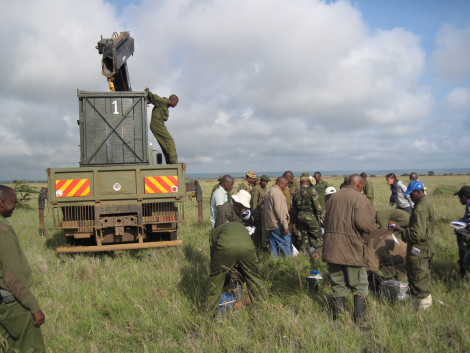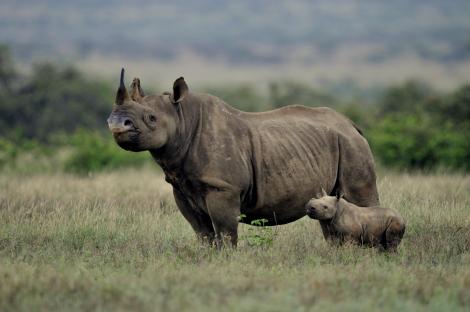Nicky Hahn & the Hahn Family
A proud history in conservation..
The Hahn Family - owners of Mugie ranch in Laikapia, Kenya
In 2010 Nicky Hahn chose to relinquish his 21-hectare Queensland Gold Coast hinterland property in Australia (and home to the Gold Coast Polo and Country Club), committing the funds to the plight of the African rhino and his Mugie Ranch in Laikapia, Kenya.
Nicolaus Hahn was born in 1936 in Switzerland, where his father, a Jewish banker from Frankfurt, had settled after fleeing the Nazis. He then spent his early days moving through England, Spain, Portugal, Cuba and Los Angeles. He attended grade school in New York, high school in Switzerland and university in Munich, where he studied economics.
He worked as a broker in Paris, London, New York and founded his own firm in Switzerland. He then took over as chair of Computer Associates, which became one of the largest software firms on the planet.Nicolaus “Nicky” Hahn, founder of Hahn Family Wines, spearheaded the creation of California’s Santa Lucia Highlands appellation (today known for world-class Pinot Noir and Chardonnay) and built his family winery into a global brand. He passed away after a long illness in Geneva, Switzerland on Friday, March 2 2018, surrounded by family. He was 81 years old.
Source: Brisbane Times - April 2010 and Winemag.com - March 2018
MUGIE RANCH (AND CONSERVANCY)
Mugie Ranch was established by the Hahn family who have been committed to Africa’s wildlife and people for over forty years. For the last 32 years, Mugie has been managed by Claus Mortensen who was born and brought up in Kenya. Mugie has preserved and increased its population of critically endangered Grevys zebra and Jackson’s Hartebeests. Through their preservation of the delicate ecosystem, the sanctuary has boosted populations of lion, oryx, elephant, giraffe, cape buffalo, eland, as well as over two hundred unique bird species.
Mugie is at the northern end of the Laikipia Plateau with a spectacular view of Mount Kenya.
Laikipia is host to many tribes but principally the Pokot, Turkana, Samburu and Il Dorobo whose people have maintained their traditional way of life. Mugie employs people from all these tribes.
Mugie is 46,000 acres but 22,000 acres have been set aside to create Mugie Sanctuary.
The Mugie sanctuary is home to around seventy species of mammal including lion, cheetah, leopard, buffalo, elephant, eland and hyena. We have many endangered species residing on Mugie including the Grevys zebra and Jacksons Hartebeest.Mugie is a venue for several conservation projects. In collaboration with the Predator Project and the Cheetah and Wild Dog Project, Mugie monitors the movement, activity, and behavior with radio tracking collars on one cheetah and two lions. The information about the movement and activities of these animals adds considerably to the knowledge base and education available.
Teams from Ekorian and Mugie gather data for Lion Landscapes by collecting lion scat samples, as well as qualitative information about the lions’ behavior and activities.
Knowing the importance of bees to the success of all living things, the Moyo Foundation and Ekorian are piloting a project in sourcing sustainable honey and connecting it with a market. The project features sustainable bee-keeping at Mugie with 20 of our own bee hives used as a barrier to elephants from Mugie’s crops.
Mugie is working hard to drive sustainable development, getting the local community involved and invested in creating a healthy future for Kenya, and furthering rangeland management and wildlife conservation.
THE MOYO FOUNDATION - in collaboration with Mugie Conservancy, The Moyo Foundation seeks to further sustainable development and community engagement, working towards a brighter future through health, education, and conservation projects. In collaboration with Ekorian and the Mugie Clinic, Moyo is working toward mobile clinics which will deliver much needed healthcare to remote communities. With a focus on women’s health and hygiene, these clinics will be fully outfitted with a supply of medicines as well as Mugie’s nurse who will provide women with information and consultations. Additionally, The Moyo Foundation sponsors several students through their education, two of whom are at the Mugie School.Mugie is also a supporting partner in the Laikipia Rabies Campaign, a program working to eradicate Rabies in Laikipia county, and recently helped to vaccinate 93 cats and dogs around Mugie.
Go back to: Local communities & NGOs
THE STORY OF SAVING THE BLACK RHINO IN KENYA (AND MUGIE RANCH)
Mugie’s rhino story began in 2004, but the stages leading up to this exceptional chapter in the ranch’s history began many years earlier following the catastrophic decline of the black rhino across Africa, after the holocaust of the 70s and 80s, in which Kenya’s rhino population plummeted from an estimated 20,000 in 1970 to fewer than 400 within 20 years.
The first movement towards rhino protection in Kenya was made in 1970, when the Wildlife and Conservation Management Department, the forerunner of today’s Kenya Wildlife Service, requested Courtland Parfet, the owner of Solio cattle ranch on the Laikipia Plateau in Central Kenya, to take in some remnant black rhinos while a permanent home was found for them. Parfet’s wife Claude, a committed conservationist, had previously persuaded her husband to allocate a 55 sq. km area of the ranch as a wildlife haven, where rhinos were already thriving, establishing Solio as the country’s first private sanctuary for rhinos. With no other secure areas available, over the next 10 years the department continued to move more rhinos into Solio and by 1980, 27 founders from nine different areas had been introduced into reserve.
It was eventually recognised after a presidential decree in 1985 to establish a dedicated rhino conservation programme that the only hope of protecting the surviving black rhinos in Kenya lay in focused security within smaller areas, allowing for more intensive protection. Government wildlife agencies and conservation organisations had to turn to private landowners, non-profit organizations and indigenous communities to protect the few remaining animals. This new sanctuary policy was centred on the development of specially protected areas and was an emergency measure to not only protect the black rhinos but to increase breeding rates.
Following the successful model of Solio Ranch, Kenya’s subsequent rhino sanctuaries were initially stocked with mostly unprotected, isolated and vulnerable rhinos living in areas outside of national parks or reserves. For several years during the 80’s, Kenya’s once wild roaming rhinos were tracked, captured and relocated, including every remaining wild rhino in northern Kenya. Established under the Kenya Rhino Project, the early ring-fenced rhino sanctuaries included Lake Nakuru National Park, Ngulia Rhino Sanctuary in Tsavo West National Park, Ngare Sergoi in Lewa Ranch (now Lewa Conservancy) and Sweetwaters Rhino Reserve (now Ol Pejeta Wildlife Conservancy). In addition, the Nairobi National Park and the Salient section of the Aberdares National Park were upgraded to rhino sanctuary status with the construction of high-security fencing and improved anti-poaching and surveillance.
In the beginning it was within these relatively small areas where the largest population of Kenya’s black rhinos were slowly and successfully growing in numbers. As populations increased, surplus rhinos from overstocked sanctuaries were relocated to supplement populations in under-stocked sanctuaries whilst being used to establish new rhino conservation areas.
And so it was, in 2004, twenty-four years after the last indigenous wild black rhinos were seen on Mugie, that the Hahn family dedicated 22,000 acres of their private ranch to create the new Mugie Rhino Sanctuary, established with a founder population of 20 black rhinos; 6 from Nairobi National Park, 10 from Lake Nakuru National Park and 4 from Solio Ranch.Mugie’s rhinos thrived in their new private and protected habitat and the breeding success rate rivalled that of any other reserve in Kenya. The newly established sanctuary offered an ideal environment providing the rhinos with all their favoured vegetation including small acacia’s, euphorbias and other palatable woody species, herbs and succulents as well as unrestricted access to water. During this time Mugie managed to achieve a hugely successful average annual rhino population growth of 7.4% p.a with 19 recorded births between 2004 and 2012.
Yet despite on-going security, several years later in 2009 the plague of poaching reached the remote corner of north-west Laikipia. On a dark evening the horns of one of Mugie’s precious rhinos were brutally hacked-off to be sold on the illegal market to Asia and the Middle-East to satiate the demand for rhino horn for use in traditional medicines. Despite the rise in demand for rhino horn, which essentially contains keratin, a substance also found in animal hooves, human nails and hair, the horn has been scientifically proven to have no medicinal value.
This first rhino poaching incident was a deep blow for all at Mugie, yet in retaliation against the threat of recurrent poaching Mugie heightened its security presence, increasing resources substantially. Other sanctuaries and specially protected areas were also forced to up-to triple the number of rangers working on their reserves with a cost, on average, of $1,200 a month to keep just one rhino alive.
Regardless of the ban on the rhino horn trade by the Convention on International Trade in Endangered Species, which took effect in 1975 and now has 175 members including Kenya, the world rhino population today has been almost been wiped out, with a loss of 90% of the entire population since the 1970s, according to the AWF.
Mugie battled to keep one step ahead of the highly organised and resourceful poaching syndicates pursuing Kenya’s remaining rhino, “…it is a complex phenomenon. Poachers are from international gangs and have sophisticated arms, and they are ready to do anything.” said Patrick Omondi of the Kenya Wildlife Service (KWS).Since 1985 Kenya’s Rhino Program and sanctuary policy has been achieving great successes but as time has passed the threats faced by the rhino have grown to an unmanageable level for many of Kenya’s dedicated rhino sanctuaries. “Private sanctuaries do not have enough money. They cannot afford to protect the rhinos” said Mordecai Ogada of the Laikipia Wildlife Forum. With one kilo (2.2 pounds) of rhino horn fetching as much as US$60,000 (45,000 euros), according to KWS estimates, the incentive to poach is just too great. Between 2007 and 2011, Kenya was recorded to have lost 75 rhinos and so far this year as many as 12 may have been killed, according to Kenya Wildlife officials.
In 2011, KWS increased their armed Special Operations team on Mugie from 9 to 38 men, increasing security, vehicles and surveillance, yet this expansion in resources still proved to be of little deterrent to the poachers and Mugie lost an additional 3 rhinos in the course of the year.
“It happened again and again” Claus Mortensen explained, describing the attempted rhino attacks and how his and other ranchers’ work had changed from basic conservation to security intelligence operations aimed at deterring poachers, “…all night and all day…you have your telephone on and radio on and when somebody calls your heart stops beating” . The personnel and management on the ground at Mugie were at great security risk with the threat of armed attacks throughout this unstable period, especially during post-poaching investigations. Yet despite the team’s time, energy and courage, overall Mugie lost 5 black and 1 white rhino to poaching.
Following these poaching outbreaks, a series of meetings were held between Mugie and the Kenyan Wildlife Service and a decision was made in late 2011 to relocate all of Mugie’s rhinos from the Sanctuary on the basis that it could not offer the increased security resources needed.
It was decided that the remaining 24 black rhinos and 1 white rhino were to be relocated to Ol Jogi Conservancy in Laikipia and to Ruma, a new KWS conservancy on the shores of Lake Victoria in western Kenya. The last rhino to leave Mugie in January 2012 was called Baraka, a bull rhino born in Nakuru National Park in 1976.
For nearly a decade Mugie invested considerable resources into protecting and preserving the endangered black rhino and did everything in its power to prevent the onslaught of poaching. Hundreds of local and international visitors have come to observe the rhinos since their arrival in 2004, learning about these magnificent mega-herbivores and their fight for survival. Mugie and its dedicated team are continuing their concerted efforts in wildlife conservation and are actively following the progress of the Mugie rhinos in their new reserves, hoping they will remain safe and continue to breed so as to secure the future of the black rhino for generations to come.
Courtesy: Mugie Ranch - June 2012
ARTICLES OF INTEREST
Kenya's fragile ecology under threat from tribal assault - Sunday Telegraph February 2017
Like a colony right inside Kenya - The National View magazine
Fragmentation: A land divided bu Amy Hardberger at Mugie.org
Go back to: Local communities & NGOs


